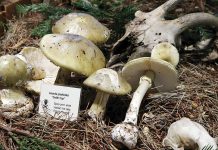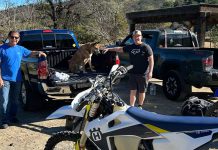Kit fox makes a stand among us
The string of photos are too dark to reproduce on newspaper
pages, but the digital images reveal something unmistakable: a San
Joaquin kit fox cavorting on tree branches in a yard along South
Ridgemark Drive.
Kit fox makes a stand among us
The string of photos are too dark to reproduce on newspaper pages, but the digital images reveal something unmistakable: a San Joaquin kit fox cavorting on tree branches in a yard along South Ridgemark Drive.
A friend, Susan Biskeborn, took the photos at about 11:20 p.m. on Sept. 26.
So what’s the big deal? Foxes commonly thrive near humans. The red fox, introduced from Europe as the object of foxhunters’ attention, has spread around the country. Leave a bowl of cat food out in an open garage, and foxes are likely to discover it before long (Ask me how I know.).
But a San Joaquin kit fox? The animal was first officially listed as endangered in 1967. Its presence has diverted bulldozers, confounded developers and attracted biologists like moths to a flame.
How could one possibly be found padding along tree branches in the middle of a sprawling, semi-urban golf course development?
The photos are incontrovertible. They depict a cat-sized fox sporting large ears. The bushy tail wears a prominent black tip. Kit fox for sure.
If they’re so rare, what could they possibly be doing hanging out around the links?
The fact is that the tiny predators are not particularly rare where the right habitat presents itself. And the right habitat is
plentiful in San Benito County. They don’t need permanent water sources because they derive their moisture from their prey, which includes everything from lizards, to hares, squirrels and birds. They’re opportunists.
What they do need are open spaces, a little cover and places to create dens for their annual litters of three to five pups.
That they are here does not mean they’re particularly common. According to the “World Wildlife Fund Guide to Endangered Species of North America,” only about 7,000 are thought to live today, almost all in a narrow Central California strip west of Interstate 5.
And that’s just the thing about our own very anecdotal experiences. The brown pelican was in critical condition in the early 1970s, when persistent pesticide pollution threatened the bird with extinction. Pulling DDT and its derivatives from the shelves resulted in the birds coming back, and in 1985 they were pulled off the Endangered Species List in the Southwestern U.S., but they remain officially endangered elsewhere, including Monterey Bay, where skeins of them are omnipresent.
The hundreds that may be roosting along the shore of Elkhorn Slough prove only one thing: that there are a lot of pelicans at Elkhorn Slough. They remain rare and vulnerable to oil spills and entanglement in fishing tackle.
So it is with the San Joaquin kit fox. It’s not oil spills, but agriculture and development that displace them.
And why should any of us care if the ungainly pelican, or pint-sized kit fox disappears entirely?
I think the disappearance of any species, even those with far less star quality than kit foxes and pelicans, leaves us all immeasurably poorer. Moreover, all living things are bound together in a Gordian knot that none of us can fully understand. Even our own bodies – no matter how fastidious – are host to organisms that depend completely on humans for survival.
I labored to find the reference at hand, but conservationist John Muir once said something like, “Pull up the tiniest blade of grass and you’ll find all living things bound to it.”
Even kit foxes.









